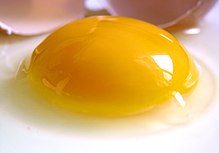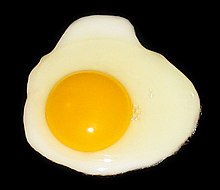Egg white: Difference between revisions
| Line 63: | Line 63: | ||
*[http://www.collodion.com/manual/ The Contemporary Wet Plate Collodion Experience Manual] at collodion.com |
*[http://www.collodion.com/manual/ The Contemporary Wet Plate Collodion Experience Manual] at collodion.com |
||
* http://www.alternativephotography.com/process_albumen_paper.html - How to make albumen photographic paper |
* http://www.alternativephotography.com/process_albumen_paper.html - How to make albumen photographic paper |
||
* [http://www.foodsdatabase.com/LinkedLabel.aspx?FoodId=16743] Nutritional Info |
|||
{{Cookbook|Eggs}} |
{{Cookbook|Eggs}} |
||
Revision as of 18:31, 4 June 2007


Egg white is the common name for the clear liquid (also called albumen, poggle, or glair/glaire) contained within an egg. It is the cytoplasm of the egg, which until fertilization is a single cell. It consists mainly of about 15% proteins dissolved in water. Its primary purpose is to protect the egg yolk and also to provide additional nutrition for the growth of the embryo, as it is rich in proteins and is of high nutritional value. Unlike the egg yolk, it contains little fat.
Uses
- It is often separated and used for cooking (for glairs, meringues, soufflés, and some omelettes), whence it derives its name: when albumen is beaten or cooked it turns white.
- In schools it is often used to teach pupils how to test for protein using Biuret reagent.
- It is used to remove sediments from champagne and beer and to clarify broths.
- It was used in the emulsion of traditional photographic paper.
Composition
The main constituent of egg white is water at 83%. Ovalbumin is the main protein constituent and is structurally a serpin (a class of proteins), although it does not have a known function in inhibiting other proteins.
There are approximately 40 different proteins in albumen.[1] The major proteins found in egg white (> 1% of the total protein content) are listed below:
Other protein components include, flavoprotein (.8%), ovoglycoprotein (.5%), ovomacroglobulin (.5%), ovoinhibitor (.1%) and avidin (.05%).
Denaturation
All proteins, including those in egg white, are made of long chains of amino acids which are similar to beads on a string. In a raw egg, these strings are raveled up in a tangled compact mass. Chemical bonds and interactions between the amino acids within each protein hold this mass in a specific shape and stop it from unraveling. As an egg cooks, the heat causes the bonds within the proteins to break, a process called denaturation.[2] As these proteins strings unfold and entangle with other proteins, new bonds form between these amino acids and the amino acids of neighboring proteins, causing the texture change in a cooked egg.
Copper (II) sulphate can also cause the same reaction, when egg albumen is placed with a strong concentration of copper sulphate, the egg white will rapidly denaturate and turn opaque, and form entangled white threads of protein, which you will see when cooking egg whites.
Cooking and preparation of egg whites
This article needs additional citations for verification. (February 2007) |
What happens to an egg white as it is beaten
The protein partially unravels and forms a good foaming agent. A foam is formed by the protein forming a stable film around the included air. Studies show that the best foam forms when the unraveling of the protein is only partial. [citation needed] Overbeating egg whites destabilises the foam by fully unravelling the protein molecules. The protein is elastic, so when the egg white is cooked, and the air expands, the white stretches then sets in the expanded position.
Use of a copper bowl to aid foaming
Many cooks recommend using a copper bowl to beat egg whites. This has the effect of making it take longer to form the foam, but leads to a much more stable foam. This is probably because the copper atoms form a complex with the conalbumin protein which makes it difficult to unravel, which means that it takes around twice the time to get a good foam, but the foam is much more difficult to overbeat. [citation needed] (The danger of overbeating may be the reason many cooks recommend beating by hand rather than using an electric whisk).
The one possible drawback of using a copper bowl is the toxicity of copper. However, the amount incorporated into the egg whites is likely to be far too small to cause ill effect.[3] In fact, egg whites are used as an antidote to copper poisoning, as the ovalbumin molecule chelates to heavy metals and traps the metal ions within the sulfhydryl bonds of the protein.
Use of cream of tartar to aid foaming
Cream of tartar (potassium bitartrate) is an acidic salt that can be used to change the pH of the egg white to an acidic range of around 3-4. This has the effect of stabilising the foam, and is therefore an alternative to using a copper bowl. Cream of tartar should not be used if a copper bowl is used, because it can react with the copper and force more of it into solution (acids react with metals, in general), thus potentially increasing the toxic effect.[citation needed] This may cause cancer.[citation needed]
References
- ^ Anatomy of an Egg at Exploratorium
- ^ Denaturation Protein at Elmhurst College
- ^ Good Eats (June, 13 2001). Let Them Eat Foam (Video). Television Food Network, G.P.
{{cite AV media}}: Check date values in:|date=(help); External link in|title=
See also
External links
- Contemporary Wet Plate Collodion Negatives & Photographs at collodion.com
- The Contemporary Wet Plate Collodion Experience Manual at collodion.com
- http://www.alternativephotography.com/process_albumen_paper.html - How to make albumen photographic paper
- [1] Nutritional Info
